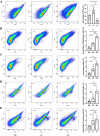Comparison of preparation methods of rat kidney single-cell suspensions
- PMID: 38307992
- PMCID: PMC10837120
- DOI: 10.1038/s41598-024-53270-2
Comparison of preparation methods of rat kidney single-cell suspensions
Abstract
Preparation of kidney tissue single-cell suspensions is the basis of single-cell sequencing, flow cytometry and primary cell culture, but it is difficult to prepare high quality whole kidney single-cell suspensions because of the complex structure of the kidney. We explored a technique called stepwise enzymatic digestion (StE) method for preparing a single-cell suspension of rat whole kidney tissue which contained three main steps. The first step is to cut the kidney into a homogenate. The second step is the digestion of renal tubules using Multi Tissue Dissociation Kit 2 and the last step is the digestion of glomeruli using type IV collagenase. We also compared it with two previous techniques, mechanical grinding method and simple enzymatic digestion method. The StE method had the advantages of high intrinsic glomerular cells and immune cells harvest rate, high singlets rate and high cell viability compared with the other two techniques. In conclusion, the StE method is feasible, highly efficient, and worthy of further research and development.
© 2024. The Author(s).
Conflict of interest statement
The authors declare no competing interests.
Figures





Similar articles
-
Comparison of methods for the preparation of single-cell suspensions of rat retina and immunophenotyping by flow cytometry.J Neurosci Methods. 2025 May;417:110384. doi: 10.1016/j.jneumeth.2025.110384. Epub 2025 Feb 7. J Neurosci Methods. 2025. PMID: 39923967
-
Optimization of mouse kidney digestion protocols for single-cell applications.Physiol Genomics. 2024 Jul 1;56(7):469-482. doi: 10.1152/physiolgenomics.00002.2024. Epub 2024 Mar 25. Physiol Genomics. 2024. PMID: 38525531 Free PMC article.
-
Preparation of single-cell suspensions of mouse glomeruli for high-throughput analysis.Nat Protoc. 2021 Aug;16(8):4068-4083. doi: 10.1038/s41596-021-00578-2. Epub 2021 Jul 19. Nat Protoc. 2021. PMID: 34282333 Review.
-
Flow-cytometric method for simultaneous analysis of mouse lung epithelial, endothelial, and hematopoietic lineage cells.Am J Physiol Lung Cell Mol Physiol. 2016 May 1;310(9):L796-801. doi: 10.1152/ajplung.00334.2015. Epub 2016 Mar 4. Am J Physiol Lung Cell Mol Physiol. 2016. PMID: 26944088 Free PMC article.
-
Isolation of thymic epithelial cells and analysis by flow cytometry.Curr Protoc Immunol. 2014 Nov 3;107:3.26.1-3.26.15. doi: 10.1002/0471142735.im0326s107. Curr Protoc Immunol. 2014. PMID: 25367128 Review.
References
MeSH terms
Grants and funding
LinkOut - more resources
Full Text Sources
Research Materials

